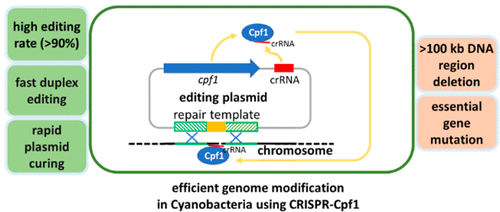当前位置:
X-MOL 学术
›
ACS Synth. Biol.
›
论文详情
Our official English website, www.x-mol.net, welcomes your
feedback! (Note: you will need to create a separate account there.)
Expanding the Potential of CRISPR-Cpf1-Based Genome Editing Technology in the Cyanobacterium Anabaena PCC 7120.
ACS Synthetic Biology ( IF 3.7 ) Pub Date : 2018-12-21 , DOI: 10.1021/acssynbio.8b00437 Tian-Cai Niu 1 , Gui-Ming Lin 1 , Li-Rui Xie 1 , Zi-Qian Wang 1, 2 , Wei-Yue Xing 1, 2 , Ju-Yuan Zhang 1 , Cheng-Cai Zhang 1
ACS Synthetic Biology ( IF 3.7 ) Pub Date : 2018-12-21 , DOI: 10.1021/acssynbio.8b00437 Tian-Cai Niu 1 , Gui-Ming Lin 1 , Li-Rui Xie 1 , Zi-Qian Wang 1, 2 , Wei-Yue Xing 1, 2 , Ju-Yuan Zhang 1 , Cheng-Cai Zhang 1
Affiliation

|
CRISPR systems, such as CRISPR-Cas9 and CRISPR-Cpf1, have been successfully used for genome editing in a variety of organisms. Although the technique of CRISPR-Cpf1 has been applied in cyanobacteria recently, its use was limited without exploiting the full potential of such a powerful genetic system. Using the cyanobacterium Anabaena PCC 7120 as a model strain, we improved the tools and designed genetic strategies based on CRISPR-Cpf1, which enabled us to realize genetic experiments that have been so far difficult to do in cyanobacteria. The development includes: (1) a "two-spacers" strategy for single genomic modification, with a success rate close to 100%; (2) rapid multiple genome editing using editing plasmids with different resistance markers; (3) using sacB, a counter-selection marker conferring sucrose sensitivity, to enable the active loss of the editing plasmids and facilitate multiple rounds of genetic modification or phenotypic analysis; (4) manipulation of essential genes by the creation of conditional mutants, using as example, polA encoding the DNA polymerase I essential for DNA replication and repair; (5) large DNA fragment deletion, up to 118 kb, from the Anabaena chromosome, corresponding to the largest bacterial chromosomal region removed with CRISPR systems so far. The genome editing vectors and the strategies developed here will expand our ability to study and engineer cyanobacteria, which are extensively used for fundamental studies, biotechnological applications including biofuel production, and synthetic biology research. The vectors developed here have a broad host range, and could be readily used for genetic modification in other microorganisms.
中文翻译:

扩展蓝藻蓝细菌PCC 7120中基于CRISPR-Cpf1的基因组编辑技术的潜力。
CRISPR系统,例如CRISPR-Cas9和CRISPR-Cpf1,已成功用于多种生物的基因组编辑。尽管CRISPR-Cpf1技术最近已在蓝细菌中应用,但在没有充分利用这种强大遗传系统的全部潜力的情况下,其使用受到了限制。使用蓝细菌Anabaena PCC 7120作为模型菌株,我们改进了工具,并基于CRISPR-Cpf1设计了遗传策略,这使我们得以实现迄今为止在蓝细菌中难以完成的遗传实验。发展包括:(1)单基因组修饰的“两个间隔”策略,成功率接近100%;(2)使用具有不同抗性标记的编辑质粒快速进行多基因组编辑;(3)使用sacB,一种赋予蔗糖敏感性的反选择标记,使活性质粒能够主动丢失并促进多轮遗传修饰或表型分析;(4)通过产生条件突变体来操纵必需基因,例如,使用编码DNA复制和修复必不可少的DNA聚合酶I的polA;(5)来自鱼腥藻染色体的大DNA片段缺失,最大118 kb,对应于迄今为止用CRISPR系统去除的最大细菌染色体区域。这里开发的基因组编辑载体和策略将扩大我们研究和设计蓝细菌的能力,这些细菌被广泛用于基础研究,包括生物燃料生产在内的生物技术应用以及合成生物学研究。在此开发的载体具有广泛的宿主范围,
更新日期:2018-12-10
中文翻译:

扩展蓝藻蓝细菌PCC 7120中基于CRISPR-Cpf1的基因组编辑技术的潜力。
CRISPR系统,例如CRISPR-Cas9和CRISPR-Cpf1,已成功用于多种生物的基因组编辑。尽管CRISPR-Cpf1技术最近已在蓝细菌中应用,但在没有充分利用这种强大遗传系统的全部潜力的情况下,其使用受到了限制。使用蓝细菌Anabaena PCC 7120作为模型菌株,我们改进了工具,并基于CRISPR-Cpf1设计了遗传策略,这使我们得以实现迄今为止在蓝细菌中难以完成的遗传实验。发展包括:(1)单基因组修饰的“两个间隔”策略,成功率接近100%;(2)使用具有不同抗性标记的编辑质粒快速进行多基因组编辑;(3)使用sacB,一种赋予蔗糖敏感性的反选择标记,使活性质粒能够主动丢失并促进多轮遗传修饰或表型分析;(4)通过产生条件突变体来操纵必需基因,例如,使用编码DNA复制和修复必不可少的DNA聚合酶I的polA;(5)来自鱼腥藻染色体的大DNA片段缺失,最大118 kb,对应于迄今为止用CRISPR系统去除的最大细菌染色体区域。这里开发的基因组编辑载体和策略将扩大我们研究和设计蓝细菌的能力,这些细菌被广泛用于基础研究,包括生物燃料生产在内的生物技术应用以及合成生物学研究。在此开发的载体具有广泛的宿主范围,











































 京公网安备 11010802027423号
京公网安备 11010802027423号